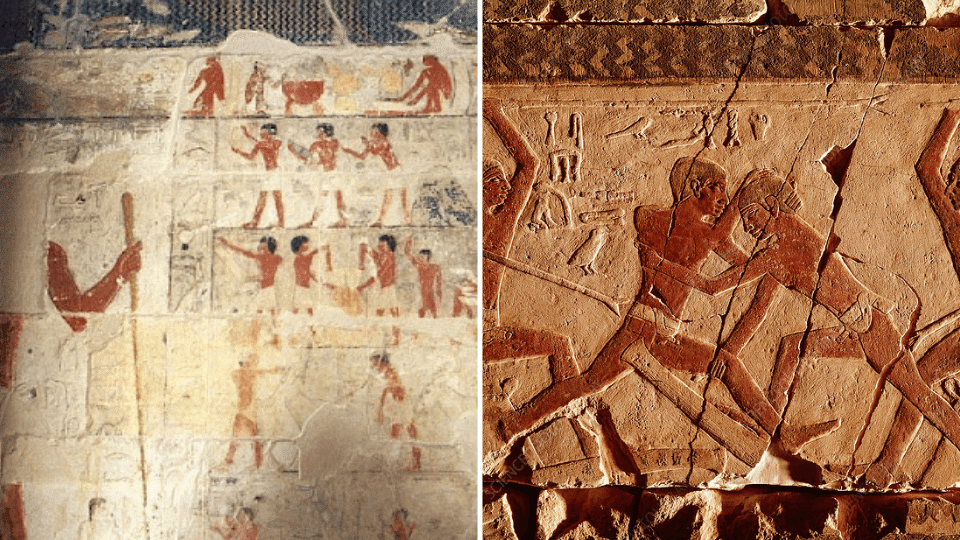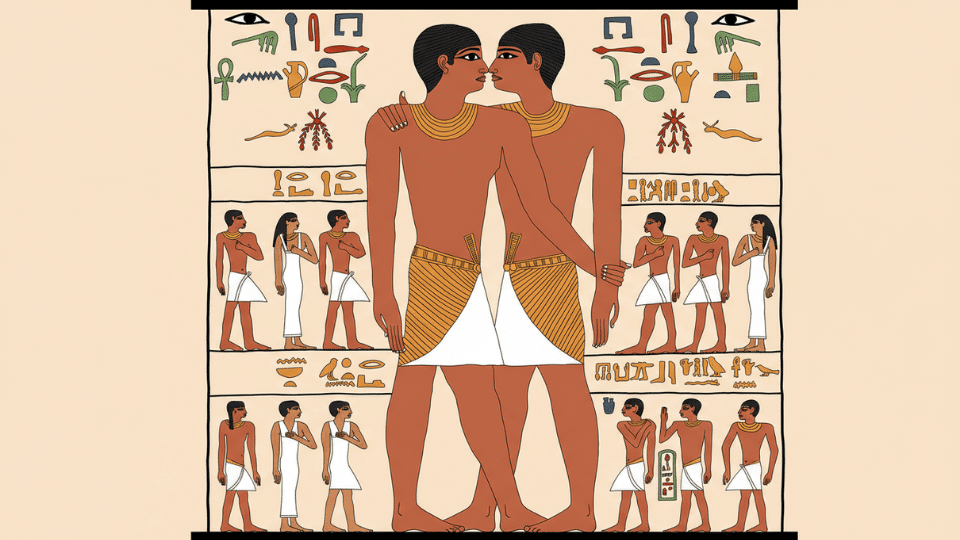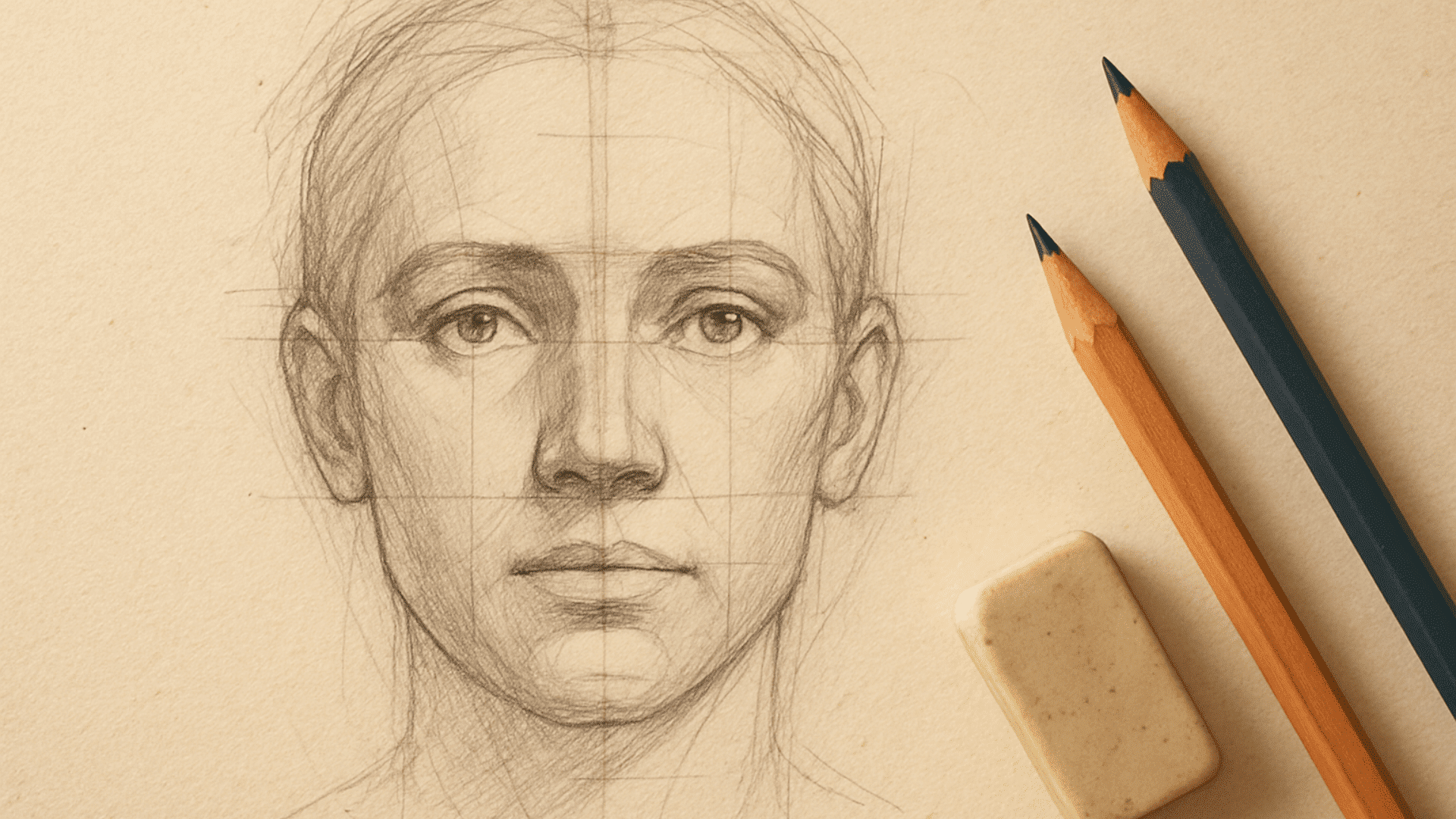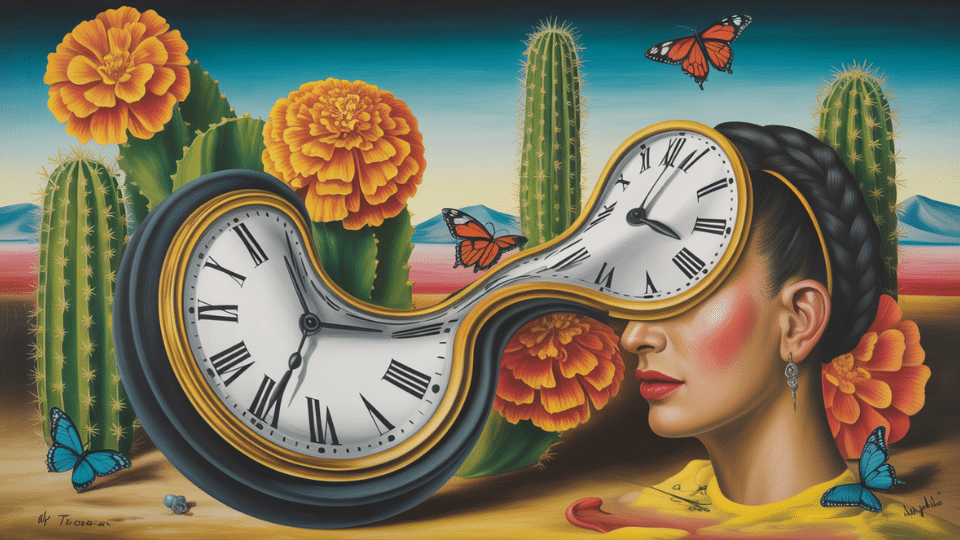Ancient Egypt’s devotion to the afterlife produced monuments that endure as testaments to faith and artistry.
Among them, the shared tomb of Khnumhotep and Niankhkhnum stands apart for its intimate depictions of two men shown hand in hand, their lives intertwined in death as in life.
Hieroglyphs describe them with titles of honor, yet their personal bond remains uncertain.
More than 4,400 years later, their tomb continues to captivate historians, offering a glimpse into the complexity of human connection in one of history’s most enduring civilizations.
The Historical Context
Khnumhotep and Niankhkhnum lived during ancient Egypt’s Fifth Dynasty, serving under Pharaoh Niuserre around 2400 BCE, a golden age of artistic achievement and lavish burial customs.
Both men held the prestigious title “Overseers of Manicurists in the Palace of the King,” a position far more significant than it sounds to modern ears.
In the royal court, personal grooming was a sacred ritual, and those who tended the pharaoh’s physical body held intimate access to divine royalty.
Their roles placed them among the elite, wealthy enough to commission a tomb that would preserve their names for millennia.
The Eternal Bond of Niankhkhnum and Khnumhotep
Beyond their prestigious titles and royal connections, these two men left behind a monument that speaks of connection, a bond so significant that they chose to spend eternity side by side.
The Mirror of Their Lives
The names themselves reveal devotion to Khnum, the ram-headed creator god who fashioned humans on his potter’s wheel.
“Khnum is satisfied,” and “Life belongs to Khnum.” Their names mirror each other like reflections, hinting at the symmetry that defined their existence.
Both served as Overseers of Manicurists, sharing not just a profession but every aspect of their lives. Historical records show they married sisters, intertwining their families as closely as their careers.
Yet the tomb’s imagery suggests something deeper, an intimacy that surpasses typical brotherhood or professional partnership, leaving modern observers to wonder about the true nature of their relationship.
Status and Significance in Egyptian Society
As Overseers of Manicurists of the Palace, they held trusted positions within the royal court, responsible for personal grooming and ritual purity roles closely linked to the divine order and the pharaoh’s sanctity.
Their upper status granted them access to wealth, artisans, and the privilege of constructing a tomb within the sacred necropolis at Saqqara, near the Pyramid of King Unas.
The choice of location, decoration, and inscriptions reflects their high social rank and the esteem in which they were held.
The Art and Symbolism of Their Tomb

Founded in 1964 by archaeologist Ahmed Moussa, the mastaba tomb at Saqqara is a key monument of the Fifth Dynasty. Its vivid wall paintings are more than decoration; they are statements of identity, affection, and belief.
Scenes depict Khnumhotep and Niankhkhnum in daily life: hunting, dining, rituals, and standing symmetrically. The most striking panel shows them nose-to-nose, symbolizing closeness and spiritual unity.
Their intertwined arms and hand-touching pose, often seen in married couples, indicate strong emotional bonds and possibly a spiritual bond beyond ordinary friendship or kinship.
The vibrant pigments and symmetry honor their achievements and eternalize their connection, ensuring their story remains one of Egypt’s most profound enigmas.
Gender, Identity, and Ancient Egyptian Society
To understand their relationship, we must first unlearn everything we think we know about love, identity, and the rules that governed ancient lives.
| Aspect | Egyptian Perspectives | Modern Perspectives |
|---|---|---|
| View on Identity | No concept of sexual orientation; relationships defined by social function (marriage, friendship, spiritual bonds) | Categories like “gay,” “homosexual,” and “same-sex partners” shape modern understanding |
| Approach to Intimacy | Physical closeness indicated social bonds; art followed strict conventions with coded meanings | Physical intimacy interpreted through modern romantic/sexual frameworks |
| Key Concepts | Ma’at (cosmic order), procreation, family continuity, spiritual eternity | LGBTQ+ representation, historical validation, identity politics |
| Fluidity | Gender and divine roles could shift; intimacy existed outside rigid categories | Debate between applying modern labels vs. respecting cultural differences |
| The Challenge | Egyptians had no vocabulary for relationships outside their framework | Risk of projecting contemporary Western concepts onto ancient cultures |
| What It Reveals | Ancient societies may have had space for bonds we can no longer categorize | Human connection has always been more complex than our categories allow |
The Legacy of Khnumhotep and Niankhkhnum
Four thousand years after their deaths, these two men continue to provoke questions, challenge assumptions, and remind us that history is never as settled as we believe.
Influence on Egyptology
The 1964 finding of their tomb sent shockwaves through academic circles, forcing Egyptologists to reconsider assumptions about ancient Egyptian society.
Their tomb opened uncomfortable but necessary conversations about what evidence we choose to see and what we ignore.
- Paradigm Shift in Interpretation: The imagery was too explicit to dismiss, too central to overlook, forcing scholars to acknowledge complexity rather than impose convenient narratives on ancient relationships.
- Catalyst for Further Research: Subsequent studies have uncovered other potential same-sex relationships in Egyptian history, from servants in royal courts to literary references previously interpreted as mere “close friendship.”
- Methodological Debates: Their tomb remains a touchstone in ongoing discussions about scholarly objectivity, challenging Egyptologists to examine their own biases when interpreting evidence of intimacy.
- Academic Legacy: They’ve changed how the field approaches personal relationships in ancient texts and tomb art, establishing new standards for historical interpretation.
Cultural Impact and Modern Recognition
Beyond academic journals, Khnumhotep and Niankhkhnum have captured public imagination as symbols of evergreen love.
Their story has surpassed Egyptology to become a cultural phenomenon, appearing across media platforms and educational contexts worldwide.
- Documentary Features: Programs like “Secrets of Egypt’s Valley of the Kings” and various History Channel specials prominently showcase the tomb, introducing its story to millions of viewers worldwide.
- LGBTQ+ Historical Canon: Books on queer history consistently cite them as evidence that same-sex relationships existed openly and were honored in ancient civilizations.
- Museum Exhibitions: Major institutions now highlight their tomb in exhibitions about diversity in antiquity, making their story accessible to general audiences beyond academic circles.
- Digital Amplification: Social media has exponentially increased its visibility, viral posts celebrate them as “the gay couple buried together in ancient Egypt,” though such simplifications trouble scholars.
Conclusion
The tomb of Khnumhotep and Niankhkhnum refuses to surrender its secrets easily.
Were they brothers bound by blood, lovers defying convention, or something ancient Egypt understood that we’ve forgotten?
Their mark, frozen in limestone for forty-four centuries, challenges us to reconsider how we define love, family, and intimacy across time.
As we stand before their painted walls, we’re left wondering: what truths about ourselves are we still carving in stone, waiting for future generations to misunderstand or finally comprehend?















